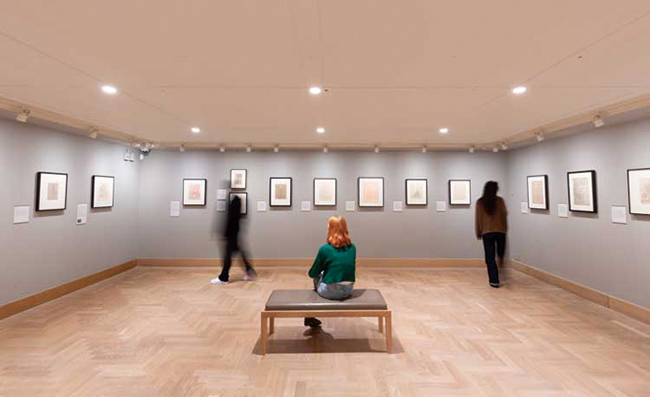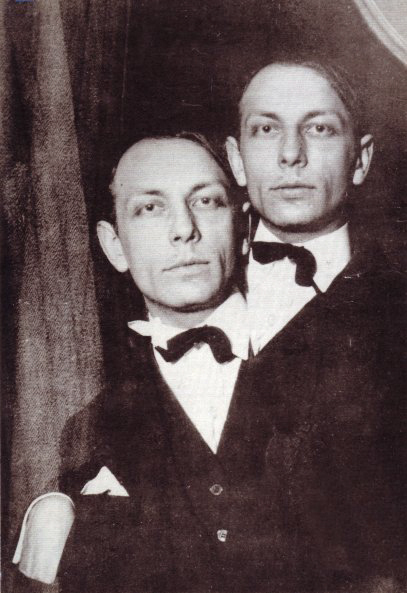This portrait of Henri Michaux (1925) by Claude Cahun, portrays him as his own double. It is an image that draws him into the orbit of Surrealist encounter with connotations of hauntology, decentred subjectivity, and estranged otherness. Perhaps the double also serves to confirm a relationship to the uncanny in which things are never as they first appear. To have embarked upon a journey into the psychological interior through ingesting mescaline to make an inscriptive recording of it, is testament to a desire to test the limits of human experience. Part of this limit experience is the question of who or what is enacting the drawing process. This question is aimed towards an attempt to understand the way the etheric body functions to regulate the relationship between the body and the energetic forces external to it.
클로드 카훈, 〈앙리 미쇼〉, 1925, 젤라틴 실버인화, 11.7 x 8.9cm
As a poet and writer, the identity of his experiments with drawing still retains a close relationship to writing, as if in part, there is a common origin for each of the practices. The closest influence on his work was with Far Eastern calligraphy and between 1930 to 1931 he travelled extensively in India, China, and Japan to better understand the cultural difference informing the cultures of East and West and in particular Buddhism. One of the effects of Mescaline and LSD is to experience a curvature within the space-time continuum and this sense is regulated by the pineal gland that is the size of a pea, but when stimulated, it can serve to alter experience of reality in profound ways.
For this reason, it became known as the mystical gland or third eye in esoteric literature.
앙리 미쇼, 〈Untitled〉, 1956, 종이 위 흑연, 잉크 © ADAGP, Paris and DACS, London 2025
From his accounts of the process of taking drugs, he submitted the various processes as if it was a scientific experiment which then in turn could be described as adhering to methodical procedures. A meeting points of aesthetic, mystical, and scientific experiment then becomes understandable as a possibility which otherwise would be open to arbitrary speculation. The drawing themselves are intensifications drawn out of the networks of the nervous system, inventing with this passage of interiority. It is as though each mark or abstract figures is dancing on clusters of nerve endings. The field that is formed assumes a life as its own and as such discharges itself as a pulsing and vibratory field formed out a contracting and expanding mass. They evoke a world, but one remote from any known world. It invites passage into an immersive terrain that links mind and matter by presenting evidence for such a deduction. On an immediate level the practice links to the European movement of Tachisme and Beat culture especially in their respective connections to Far Eastern art, poetry, and philosophy. This framework links Romanticism, Symbolism, and Surrealism into a counter rhythmical expressive force field which became party to structured, as well as casual employment of drug induced experience. Experiments that related to the expansion of the mind were in turn readily linked aesthetic innovation and intuition. Michaux was a cult figure within the margins of sixties Counterculture, both because of his literary contribution (extreme literature), and his graphical production related to psychedelics. On a literary level, he forms a potent link between figures such as Georges Bataille and Antonin Artuad, and with this, the notion of culture absorbing the dark, transgressive margins of aesthetic presentation. This exhibition should serve to draw Michaux into the broader reconfiguration of drawing practice, which has become so evident in recent attention to it.

《Henri Michaux- The Mescaline Drawing》전시전경 © Fergus Carmichael, The Courtauld Gallery
앙리 미쇼, 내면과 감각 경계의 탐구
번역 류지연 jiyeon.ryu@alumni.rca.ac.uk
클로드 카훈이 1925년에 촬영한 앙리 미쇼의 이 초상 사진은, 미쇼 자신이 그의 '이중자 (doppelgänger)'로 등장하는 모습을 보여준다. 이 이미지는 초현실주의적인 만남의 세계로 그를 끌어들이며, 여기에 '유령론(hauntology)', 중심이 해체된 주체성, 그리고 낯선 타자성의 함축을 담고 있다. 이 이중자적 이미지가, 사물들이 처음 보이는 것과 결코 같지 않다는 '섬뜩한(Uncanny)' 것과의 관계를 확인시켜주는 역할을 하는 것일지도 모른다.
미쇼는 메스칼린을 섭취하여 심리적 내부 세계로의 여행을 감행하고, 그 경험을 '기록하는 방식'으로 남김으로써 인간 경험의 한계를 실험하려는 욕망을 드러낸다. 이 극한의 경험은 누가, 또는 무엇이 그리기의 주체가 되는가라는 질문을 낳는다. 이 질문은 에테르체(etheric body)가 어떻게 육체와 외부의 에너지 사이의 관계를 조절하는지를 이해하고자하는 시도와 맞닿아 있다.
시인이자 작가로서, 그의 드로잉 실험은 여전히 글쓰기와 긴밀한 관계를 유지하고 있다.
마치 이 두 예술 행위는 공통의 기원을 공유하는 것처럼 보인다. 그의 작업에 가장 밀접한 영향은 극동 아시아의 서예에서 왔으며, 그는 1930년부터 1931년 사이 인도, 중국, 일본을 광범위하게 여행하며 동서양의 문화 차이와 특히 불교를 이해하려 노력했다.
메스칼린과 LSD의 효과 중 하나는 시공간의 만곡(curvature)을 체험하게 하는 것인데, 이러한 감각은 완두콩 크기의 송과선(pineal gland)에 의해 조절된다. 이 송과선이 자극을 받으면 현실에 대한 경험을 심오하게 변화시킬 수 있기 때문에, 신비학적 문헌에서는 이를 ‘제3의 눈(third eye)’ 또는 ‘신비의 샘’이라 불렀다.
그는 약물을 복용한 체험을 과학적 실험처럼 기술하며, 그 과정을 절차적으로 기록했다. 이로써 미적, 신비적, 과학적 실험이 교차하는 지점이 임의적 상상이 아닌 구체적인 가능성으로서 나타난다. 그의 드로잉은 신경계의 네트워크에서 비롯된 집중적인 표출이며, 각 선과 추상적 형상들은 마치 신경 말단 위에서 춤을 추는 듯하다.
그 결과 형성된 장(field)은 그 자체의 생명력을 가지며, 수축과 팽창을 반복하는 덩어리에서 비롯된 맥동하는 진동 장이 된다. 이들은 현실과는 동떨어진 세계를 불러일으키며, 물질과 정신을 연결하는 몰입적 지형으로 우리를 초대한다. 이러한 감각적 드로잉은 유럽의 타쉬즘(Tachisme)과 비트 문화(Beat culture)와도 직접 연결되며, 이들 역시 극동 예술, 시, 철학과의 연결을 추구했다.
이런 틀은 낭만주의, 상징주의, 초현실주의를 리듬적으로 반전시키는 표현의 힘으로 이어지며, 구조화된 방식이든 우연적인 방식이든 약물 체험이 동반된 예술 표현으로 전개되었다. 미쇼는 1960년대 반문화(Counterculture)에서 컬트적인 인물로 여겨졌는데, 이는 그의 극단적인 문학 작품과 환각제와 관련된 드로잉 작업 때문이다.
문학적 측면에서 그는 조르주 바타이유(Georges Bataille), 안토냉 아르토(Antonin Artaud)와 연결되며, 문화가 미학적 표현의 어두운 경계를 흡수하는 방식과도 연관된다. 이 전시는 미쇼를 현대의 드로잉 실천의 재구성이라는 보다 넓은 틀 속으로 끌어들이는 시도가 될 것이다.

 0
0
 0
0